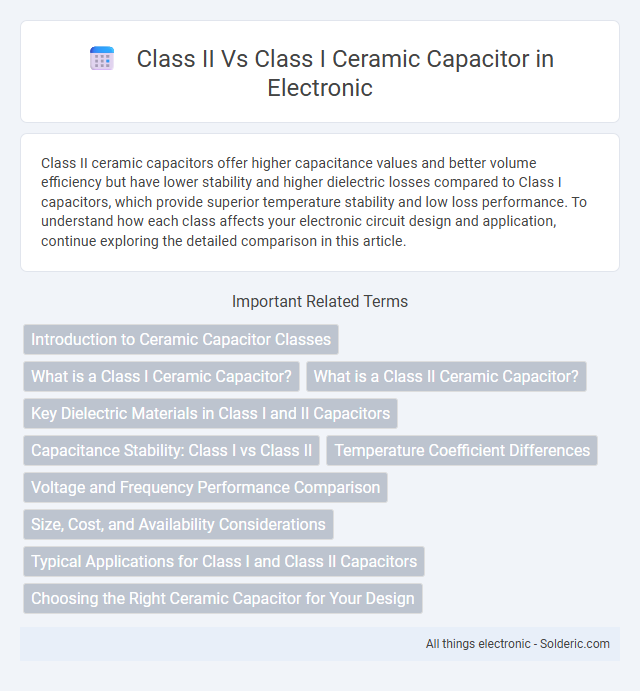Class II ceramic capacitors offer higher capacitance values and better volume efficiency but have lower stability and higher dielectric losses compared to Class I capacitors, which provide superior temperature stability and low loss performance. To understand how each class affects your electronic circuit design and application, continue exploring the detailed comparison in this article.
Comparison Table
| Feature | Class I Ceramic Capacitor | Class II Ceramic Capacitor |
|---|---|---|
| Dielectric Material | C0G (NP0), U2J | X7R, X5R, Y5V |
| Temperature Stability | +-30 ppm/degC (excellent) | +-15% to +-22% over rated temperature |
| Capacitance Range | Small (pF to nF) | Higher (nF to uF) |
| Dielectric Constant | Low (10 to 100) | High (1000 to 4000) |
| Voltage Rating | Up to 1000V | Up to 500V |
| Loss Factor (Dissipation Factor) | Very low (<0.001) | Moderate (0.02 to 0.05) |
| Applications | Precision timing, RF circuits, filters | General decoupling, bypass, bulk storage |
| Price | Generally higher | Generally lower |
Introduction to Ceramic Capacitor Classes
Class I ceramic capacitors offer stable capacitance with low dielectric loss, making them ideal for precision and high-frequency applications requiring consistent performance. Class II ceramic capacitors provide higher capacitance values in smaller sizes but exhibit greater temperature and voltage dependence, suitable for general-purpose bypass and decoupling tasks. Understanding your application's tolerance for capacitance variation and performance stability helps determine the appropriate ceramic capacitor class.
What is a Class I Ceramic Capacitor?
Class I ceramic capacitors offer high stability and low losses, making them ideal for precision applications requiring tight tolerance and minimal temperature-induced capacitance variation. They typically use C0G (NP0) dielectric material, which ensures a near-zero temperature coefficient and excellent frequency characteristics. Your choice of a Class I ceramic capacitor supports circuits demanding consistent performance over a wide temperature range and high-frequency conditions.
What is a Class II Ceramic Capacitor?
A Class II ceramic capacitor is a type of capacitor characterized by its high dielectric constant, allowing for larger capacitance values in smaller sizes compared to Class I capacitors. These capacitors are commonly used in applications requiring moderate stability and high volumetric efficiency, such as in bypass and decoupling circuits. Your choice of a Class II ceramic capacitor offers better capacitance density but comes with higher temperature and voltage dependencies than Class I types.
Key Dielectric Materials in Class I and II Capacitors
Class I ceramic capacitors utilize stable dielectric materials such as C0G (NP0), prized for their low loss and minimal capacitance variation over temperature. Class II ceramic capacitors commonly employ dielectrics like X7R, X5R, or Y5V, which offer higher permittivity but exhibit greater capacitance variation and temperature sensitivity. These dielectric compositions in Class II capacitors enable higher capacitance per volume at the cost of reduced stability compared to Class I types.
Capacitance Stability: Class I vs Class II
Class I ceramic capacitors exhibit superior capacitance stability with minimal variation over temperature, voltage, and aging, typically maintaining tolerance within +-1% to +-5%. Class II ceramic capacitors offer higher capacitance values but experience significant variation, often +-10% to +-20%, due to temperature coefficients and voltage dependency. This makes Class I preferred for precision and stability-critical applications, while Class II suits bulk capacitance requirements where capacitance drift is acceptable.
Temperature Coefficient Differences
Class I ceramic capacitors exhibit a very stable temperature coefficient, typically ranging from +-30 ppm/degC to +-200 ppm/degC, making them ideal for precision applications requiring minimal capacitance variation. Class II ceramic capacitors, on the other hand, have a much higher temperature coefficient, often varying between +-15% to +-50% over the temperature range, due to their dielectric material composition. You should choose Class I capacitors when temperature stability is critical, while Class II capacitors are better suited for higher capacitance values where some temperature variation is acceptable.
Voltage and Frequency Performance Comparison
Class I ceramic capacitors exhibit superior voltage stability with minimal capacitance change under high voltage stress, maintaining performance at frequencies up to several MHz. Class II ceramic capacitors offer higher capacitance values but experience significant capacitance variance and increased dielectric losses as voltage and frequency increase, limiting their efficiency above 1 MHz. For applications demanding consistent capacitance and low dissipation factor at elevated voltages and frequencies, Class I capacitors are preferred over Class II types.
Size, Cost, and Availability Considerations
Class II ceramic capacitors typically offer smaller sizes with higher volumetric efficiency compared to Class I capacitors, making them suitable for compact electronic designs. They are generally more cost-effective due to their widespread manufacturing and use in consumer electronics, driving economies of scale. Class II capacitors have greater availability in a broad range of capacitance values and voltage ratings, but they exhibit higher dielectric losses and less stability compared to Class I types.
Typical Applications for Class I and Class II Capacitors
Class I ceramic capacitors, with their low dielectric loss and high stability, are typically used in precision timing circuits, oscillators, and RF applications where frequency response and temperature stability are critical. Class II ceramic capacitors, offering higher capacitance values but with greater tolerance and temperature dependence, are commonly applied in decoupling, coupling, and filtering circuits within power supply lines and general-purpose electronic devices. You should select Class I capacitors for applications requiring accuracy and stability, while Class II capacitors suit high-capacitance needs in less critical stability environments.
Choosing the Right Ceramic Capacitor for Your Design
Class I ceramic capacitors offer stable capacitance with low loss and minimal temperature coefficient, making them ideal for precision circuits that require high accuracy. Class II ceramic capacitors provide higher capacitance values but exhibit greater capacitance variation with temperature and voltage, suitable for decoupling and filtering applications where size and cost efficiency are prioritized. Understanding your design's tolerance for capacitance changes and stability needs will help you choose the appropriate class for optimal performance.
class II vs class I ceramic capacitor Infographic

 solderic.com
solderic.com